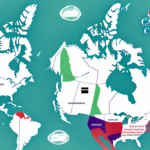Understanding FedEx Shipping Rates from the US to Canada
If you're looking to ship items internationally, FedEx is undoubtedly one of the most reliable and widely used shipping options available. However, if you're shipping from the US to Canada, you may be wondering about the various factors that influence FedEx shipping rates and how to effectively keep your costs down.
Why FedEx is a Popular Shipping Option for International Deliveries
FedEx offers a number of key benefits that make it a popular choice for international shipments. One of the main advantages of using FedEx is their extensive network of delivery options and their expertise in navigating the complexities of international shipping. According to FedEx’s [2023 Annual Report](https://www.fedex.com/en-us/about/annual-reports.html), their global network spans over 220 countries and territories, providing comprehensive coverage and reliable delivery services.
Additionally, FedEx provides a range of robust tracking and insurance options for added peace of mind. With real-time tracking capabilities, customers can monitor their shipments at every stage, reducing uncertainty and enhancing the overall shipping experience.
Another reason why FedEx is a popular choice for international shipments is their commitment to sustainability. FedEx has implemented several eco-friendly initiatives, such as using alternative fuels and investing in energy-efficient technologies, to reduce their carbon footprint. In 2023, FedEx reported a reduction in emissions intensity by 20% compared to 2019 levels, highlighting their dedication to environmental responsibility. This not only benefits the environment but also helps to reduce shipping costs for customers in the long run.
Factors That Influence FedEx Shipping Rates from the US to Canada
Several key factors can influence the shipping rates you pay with FedEx for deliveries to Canada. These include:
- Weight and Dimensions: The weight and size of your package directly impact the shipping cost. FedEx uses dimensional weight pricing, which considers both the size and weight of the package.
- Delivery Speed: Faster delivery options, such as FedEx Express, come at a higher cost compared to ground shipping.
- Additional Services: Services like insurance, signature confirmation, and special handling for fragile or hazardous materials add to the overall cost.
- Distance: The distance between the origin and destination affects the shipping rate. Longer distances typically result in higher costs.
- Type of Goods: Certain items, such as electronics, perishables, or hazardous materials, may incur additional fees due to their handling requirements.
- Seasonal Demand: During peak seasons, such as holidays, shipping rates may increase due to higher demand and limited capacity.
For a detailed breakdown of these factors, refer to FedEx’s [Shipping Rates Guide](https://www.fedex.com/en-us/shipping/rates.html).
Understanding Dimensional Weight and How It Affects Your Shipping Costs
One important concept to understand when it comes to international shipping costs is dimensional weight. This refers to the amount of space your package takes up on a delivery vehicle compared to its actual weight. Essentially, if your package is very large but light in weight, you may pay more to ship it than you would for a smaller, heavier package. Understanding this concept can help you effectively plan and budget for your shipments to Canada.
Different shipping carriers may have different formulas for calculating dimensional weight. FedEx, for example, uses a formula that considers the package’s length, width, and height. It’s crucial to check with your chosen carrier to understand their specific dimensional weight calculation method and factor it into your shipping cost calculations.
According to industry data from UPS, dimensional weight pricing is becoming increasingly common to encourage the efficient use of cargo space. As a result, optimizing your package dimensions can lead to significant cost savings.
Tips for Reducing Your FedEx Shipping Costs to Canada
Fortunately, there are several strategies you can employ to help reduce your FedEx shipping costs when shipping to Canada:
- Bundle Packages: Combining multiple items into a single shipment can reduce the overall shipping cost compared to sending them individually.
- Utilize Flat-Rate Shipping: FedEx offers flat-rate options for certain package sizes, allowing you to ship items at a predictable cost regardless of weight.
- Take Advantage of Discounts: Frequent shippers can benefit from FedEx’s discount programs, which offer reduced rates based on shipping volume.
- Optimize Packaging: Use the smallest possible box or envelope that fits your items and minimize the use of void fill or cushioning materials. This reduces both the weight and size of your package, potentially lowering shipping costs.
- Choose Slower Delivery Options: If your shipment is not time-sensitive, opting for a slower delivery service can result in lower shipping costs.
- Schedule Shipments in Advance: Planning your shipments ahead of time can help you take advantage of available discounts or promotions.
Implementing these strategies can lead to substantial savings on your FedEx shipping expenses.
How to Compare FedEx Rates with Other Shipping Carriers for Canadian Deliveries
It's always a good idea to compare shipping rates from different carriers before making a decision. This can help you ensure that you're getting the best price and the most reliable service for your needs. Utilizing online tools that allow you to compare shipping rates side-by-side can make this process much easier and more streamlined.
- Consider Total Cost: Look beyond the base rate and consider additional fees or surcharges that may apply.
- Evaluate Delivery Times: Ensure that the carrier meets your delivery time requirements without unnecessary delays.
- Assess Service Levels: Different carriers offer varying levels of service, such as tracking accuracy, customer support, and handling of special items.
According to a [2023 survey by the National Shipping Institute](https://www.nationalshippinginstitute.org/reports/2023-shipping-survey), carriers like UPS and DHL also offer competitive rates and services that may better suit certain shipping needs. Additionally, reaching out directly to shipping carriers for personalized quotes can provide more accurate comparisons tailored to your specific requirements.
Understanding FedEx's Delivery Times and Transit Options for Shipments to Canada
When shipping to Canada with FedEx, you'll need to be familiar with their various delivery options and estimated transit times to ensure that your package arrives when you need it. FedEx offers several transit options, including:
- FedEx Ground: The most cost-effective option, suitable for less urgent shipments. Transit times typically range from 1 to 7 business days depending on the distance.
- FedEx Express Saver: Delivers within 3 business days by 4:30 PM to most areas.
- FedEx International Priority: Offers expedited delivery within 1 to 3 business days to major Canadian cities.
Ground shipping with FedEx is the most economical choice, but it can take longer compared to express services. For example, a shipment from New York to Toronto via FedEx Ground may take approximately 2 business days, whereas FedEx International Priority can deliver the same package in as little as 24 hours.
It’s important to note that delivery times may vary based on the destination within Canada. Remote areas may experience longer transit times compared to major urban centers. To get accurate transit estimates, use FedEx’s [rate and transit time tool](https://www.fedex.com/en-us/shipping/rates.html) on their website.
The Importance of Proper Packaging for International Shipments with FedEx
Proper packaging is crucial when shipping items internationally with FedEx. It ensures that your items arrive safely and in good condition, reducing the risk of damage or loss during transit. Here are some key considerations:
- Use Sturdy Materials: Select high-quality boxes and packing materials that can withstand handling and environmental conditions during transit.
- Secure Packaging: Ensure that all items are well-protected with padding and that boxes are properly sealed to prevent tampering or accidental openings.
- Compliance with Regulations: Different countries have specific packaging regulations. For instance, Canada may require certain labeling or restrictions on materials. Always check FedEx’s [International Packaging Guidelines](https://www.fedex.com/en-us/shipping/international/packaging.html) to ensure compliance.
- Labeling: Clearly label your packages with accurate addresses and any required customs information to avoid delays in shipping.
Proper packaging not only protects your items but also helps expedite the customs clearance process, reducing the likelihood of unexpected delays or additional costs. According to the [Canadian Border Services Agency](https://www.cbsa-asfc.gc.ca/import/menu-eng.html), correctly labeled and packaged shipments are processed more efficiently, ensuring timely delivery.
How to Track Your FedEx Package from the US to Canada
One of the many advantages of using FedEx for international shipments is their sophisticated tracking system. This allows you to closely monitor the progress of your package from the moment it leaves your hands until it reaches its final destination in Canada. Utilizing tracking services can help you stay on top of any potential delays or issues with your shipment and can give you peace of mind throughout the process.
To track your FedEx package from the US to Canada, you will need to have your tracking number handy. This number can be found on your shipping label or in the confirmation email you received when you placed your order. Once you have your tracking number, simply visit the [FedEx Tracking Tool](https://www.fedex.com/en-us/tracking.html) and enter it into the tracking field. You will then be able to see the current status of your package, including its location and estimated delivery date.
If you encounter any issues or have questions about your shipment, FedEx customer service is available to assist you. They offer support through multiple channels, including phone, email, and live chat, ensuring that you can get the help you need promptly.
Conclusion: Is FedEx the Right Choice for Your US-Canada Shipping Needs?
Ultimately, whether or not FedEx is the right choice for your US-Canada shipping needs depends on various factors, including your budget, shipment volume, and specific delivery requirements. By understanding the factors that can impact your shipping rates and taking steps to manage your costs effectively, you can ensure that you're maximizing the value of your international shipping partnerships with FedEx.
Another important factor to consider is FedEx’s customer service. FedEx has a strong reputation for providing excellent customer support, with a dedicated team of representatives available to assist with any questions or concerns. This is particularly valuable when dealing with international shipments, which may involve additional customs or regulatory requirements.
Additionally, FedEx offers a range of value-added services that can streamline your shipping process and enhance your overall experience. These services include package tracking, delivery confirmation, and customs clearance assistance. By leveraging these services, you can ensure that your shipments are delivered on time and in compliance with all relevant regulations, while minimizing the risk of lost or damaged packages.




















